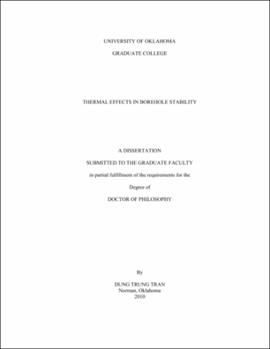| dc.contributor.advisor | Rogiers, Jean-Claude | |
| dc.creator | Tran, Dung | |
| dc.date.accessioned | 2019-04-27T21:38:27Z | |
| dc.date.available | 2019-04-27T21:38:27Z | |
| dc.date.issued | 2010 | |
| dc.identifier | 9940338702042 | |
| dc.identifier.uri | https://hdl.handle.net/11244/319239 | |
| dc.description.abstract | An accurate wellbore stability analysis depends strongly on the state of knowledge of the problem at hand. Almost in all cases, the state of knowledge for wellbore stability analyses is poor. Values of many parameters and variables (so-called prior geological information) are poorly constrained and various assumptions of the adopted wellbore models are easily violated. The dilema is that using a model requiring few input parameters would suffer from a large number of model assumptions and simplifications; while using a complex model requiring a large number of input parameters which have wide ranges of possible values. Therefore, assessing the uncertainty (or degree of confidence) for different possible wellbore stability/instability scenarios remains difficult. Current sensitivity analyses, which consider varying possible values of one parameter while keeping others constant, are suboptimal and may not provide the correct effects of the parameters' uncertainties on the overall uncertainty of the wellbore stability prediction. | |
| dc.description.abstract | Recent technological advances such as logging-while-drilling (LWD) and measuring-while-drilling (MWD) enable real-time updating of measured rock properties values and in-situ conditions. This means the ranges and uncertainties of parameters for wellbore stability analyses can be adjusted in real-time, during drilling. This aspect has not been developed into a self-updating, real-time wellbore stability analysis approach yet. | |
| dc.description.abstract | As a step toward that goal, this dissertation presents several studies covering different aspects of wellbore stability. In particular, the uncertainties of input parameters and selected models are treated using a probabilistic framework combining Monte Carlo simulations and Bayesian statistics. | |
| dc.description.abstract | The uncertain nature of both input parameters and model assumptions and their effects on the uncertainties of wellbore stability predictions are investigated. It is shown that, depending on the severity of parameters' uncertainties, the use of complex wellbore models might not necessarily reduce the uncertainty of the predictions, contrary to popular belief. | |
| dc.description.abstract | The following studies explore the quantifications of rock parameters' uncertainties (ranges) that are used as input in a wellbore stability analysis. Firstly, three equivalent forms of Gassmann's equation are presented. These equations were applied to several sets of laboratory measurements (Berea sandstones and Bedford limestones) to determine the grain matrix bulk modulus and Biot-Willis coefficient based on measured compressive and shear velocities. A stochastic simulation was performed to examine the effect of uncertainty and/or measurement errors on calculated grain matrix bulk modulus and Biot-Willis coefficient. The results showed that the calculated grain matrix bulk modulus is relatively constant with applied differential pressure (up to 50 MPa) for sedimentary rocks, whereas Biot-Willis coefficient is a function of the confining pressure. Small errors in dry and saturated bulk modulus values (or of velocities), however, can significantly affect the calculated grain bulk modulus and Biot-Willis coefficient values. | |
| dc.description.abstract | The uncertainties of rock failure parameters (Uniaxial Compressive Strength, cohesion, and internal friction angle) obtained from laboratory experiments are considered next. It is shown that different testing procedures and data analysis methods result in very different input rock failure parameter values. A new analytical solution to find the best-fit Mohr-Coulomb failure envelope from N Mohr's circles based on Least-Absolute Errors is presented, showing comparable results with those deduced from established least-square regression approaches. The problem is converted into N linear systems that can be solved readily using a common linear programming method. This method is found to be more useful than least-square regression when one has to deal with data sets of mixed qualities. | |
| dc.description.abstract | Finally, a wellbore stability analysis demonstration using a probabilistic approach is presented for the Barnett Shale. The selected porothermoelastic model shows that the cooling effect due to a ~30 °C temperature difference between the drilling mud and the formation is most likely the cause of the transverse tensile failures observed in horizontal open-hole borehole imaging logs. | |
| dc.format.extent | 172 pages | |
| dc.format.medium | application.pdf | |
| dc.language | en_US | |
| dc.relation.requires | Adobe Acrobat Reader | |
| dc.subject | Boring | |
| dc.subject | Oil well drilling | |
| dc.title | Thermal Effects in Borehole Stability | |
| dc.type | text | |
| dc.type | document | |
| dc.thesis.degree | Ph.D. | |
| ou.group | Mewbourne College of Earth and Energy::Mewbourne School of Petroleum and Geological Engineering | |
